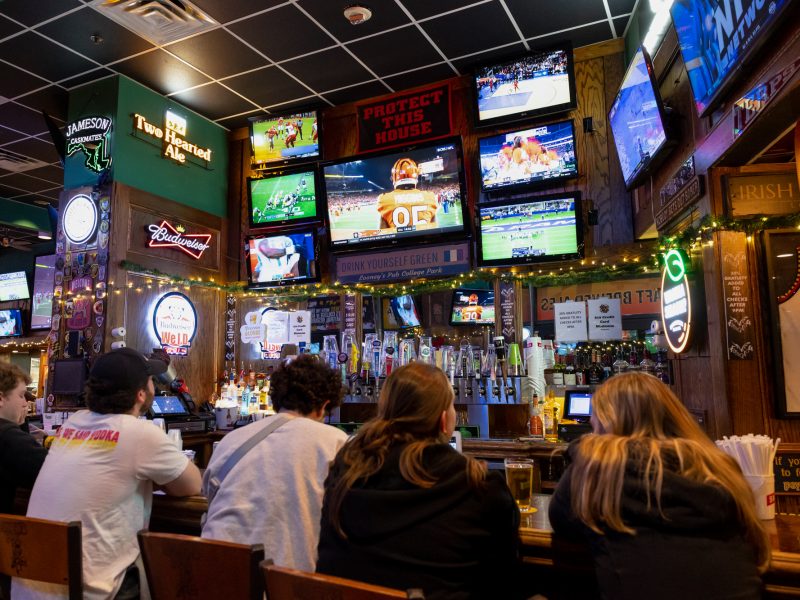When Emilia Guzmán’s friend turned 13, dozens of middle schoolers attended the birthday party. Her friend’s mother rented a karaoke machine, but most girls crowded around the snack table.
White macadamia cookies, miniature key lime pies and sandwiches were scarfed down, quickly replaced with a new dish.
“You felt this desire [to] try everything,” the freshman economics major said. “The only person who wasn’t eating as much was the birthday girl.”
Guzmán was nearing her 30th cookie when another friend bit into a pie, remarking on how painful it was to eat.
Waking up the next day, Guzmán was so full she couldn’t drink water without crying in pain. Weeks later, her parents took her to a psychiatrist where she was prescribed an antidepressant used to treat binge eating disorders.
Guzmán was born in Washington, D.C., but grew up in Lima, Peru. Eating disorders were common in her all-girls school. However, her Peruvian family members advised her not to tell classmates about her medication.
The Peruvian mental health stigma dates back to the colonial era, when families considered mental illness the “work of the devil,” according to Marta Rondon, a psychiatry consultant at the National Institute for Maternal and Perinatal Health.
Poor mental health, in turn, brings shame to families, who often try to hide a relative’s mental illness. As a result, mental health was misunderstood among the general population.
“People don’t understand that it is the state of wellbeing that allows you to realize your potential, deal with stress, work and make a contribution to your community,” Rondon said. “They still think that you have to avoid stress, not to learn to deal with stress.”
[Mental health stories beyond UMD: International students discuss mental health experiences]
General knowledge about eating disorders is also low in Latin America and the United States, according to Mae Lynn Reyes-Rodriguez, a clinical psychologist and professor on eating disorders in the psychiatry department of the University of North Carolina at Chapel Hill.
Historically, clinical diagnosis and treatment processes for eating disorders were geared toward white, European, middle class women, Reyes-Rodriguez said. As a result, the misconception that Latinos aren’t as likely to develop eating disorders because their cultures embrace the curvy body type for women leads to a lack of awareness.
Since eating disorders overlap with signs of anxiety and depression, clinicians often treat those symptoms without acknowledging the eating disorder. This comes in part from a lack of available resources, which limits proper treatment.
Insufficient information at clinics also furthers limited awareness among Latino families, where it’s also normal to comment on others’ bodies, Reyes-Rodriguez said.
Guzmán’s mother often commented on her weight, calling her fat despite her size small school uniform skirt falling off her waist. Guzmán even bonded with classmates over similar interactions they had with their mothers.
Guzmán’s mother grew up in Peru during the 1980s. At this time, the country grappled with periods of recession, hyperinflation and violent guerilla insurgency, according to an article published in the Latin American Research Review by Manuel Pastor and Carol Wise of the University of Southern California.
Fresh food was expensive. Her mother mostly ate bread and pasta. Guzmán’s grandmother commented on her mother’s weight constantly, ingraining the idea they must weigh no more than 100 pounds, Guzmán said.
When Guzmán used food to cope with trouble making friends in fifth grade, the comments from her mother’s family continued.
“I did everything that I could to lose weight,” Guzmán said. “I got to 100 pounds, and I said, ‘OK, now I’m never going to gain weight.’ … It was a huge struggle for me because I couldn’t eat peacefully.”
By middle school, Guzmán was eating less than 800 calories a day and binging on the weekends, she said. When Monday came around, her reflux and heartburn made eating anything more than toast unbearable.
“I lost my period. My hair was falling [out], and I just felt cold all the time,” Guzmán said. “I don’t know how I’m still alive based on how little I ate.”
Tired of keeping her struggle to herself, Guzmán told a close friend on the bus that she was on medication for anxiety. She received a surprising response: “Me too.”
Guzmán started to open up to more classmates, who often chimed in with which medications they took. But even when treatment is available, medications are expensive and sometimes health insurance won’t cover the cost.
[How a UMD student navigated cultural mental health stigma, treatment]
Once Guzmán moved back to the U.S. at 17, she was diagnosed with hyperthyroidism, a condition that speeds up the body’s metabolism and can cause weight loss.
She visits her doctor for monthly checkups to monitor her weight and mental state. When Guzmán’s body image improved, her psychiatrist even stopped her medication.
But her anxiety didn’t stem solely from her eating disorder. After family conflict erupted, Guzmán could barely pay attention in class and was afraid of getting overwhelmed and having a panic attack.
Her psychiatrist prescribed an anxiety medication to help her manage her panic attacks.
“I started crying because I wasn’t feeling anything,” Guzmán said. “It was a cry of relief.”
Peru shifted toward reforming mental health services in 2018 when the Ministry of Health approved five policy guidelines on mental health, according to The Lancet Psychiatry, a peer-reviewed scientific journal.
Peru went from three mental health hospitals with virtually no outpatient services to providing psychiatric and outpatient services in every large hospital in the country, Rondon said. More than 200 community mental health centers also provide treatment, with teams dispensing medication at home.
Resources are still mostly concentrated in urban areas, but as primary care staff receive training on signs of depression and anxiety, more Peruvians are referred to psychologists.
“We’re still lacking in services, but it has improved a lot,” Rondon said.



